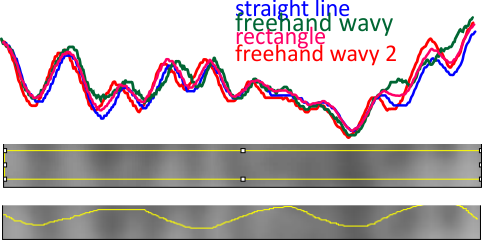Not much changes the height plot in AFM images if the peaks are readily discernible with the naked eye (brightness peaks counted by hand awas 11) then changing the properties of the bounding box in LUT plot (plotted peaks = 11) analyses just really doesn’t make much of a difference…. at least in this example it matters precious little. These plots were aligned from the tip of the first peak to the tip of the second peak. Plot y axis was not change and exported automatically from Image2-Fiji. Examples of freehand wavy and rectangle below the plots. So after a year or more of trying to figure out the basics methods with which i am comfortable in terms of morphometry are the following.
1) optimize the image to 300ppi
2) measure curve SP-D arms using a vector line which is measured at cusp points (nodes).
3) trim excess (eraser or crop) background away from the hexamer (CRD to Nterminus to Nterminus to CRD on the other end of the hexamer.
4) apply a straightening technique (1nm slices which are centered horizontally)
5) export image as compatible file for ImageJ23Figi (or ImageJ)
6) drag rectangle from edge to edge and at a width that encompasses the most favorable area)
7) analyze>plot profile> then save to excel
8) plot import as metafile to CorelDRAW
9) evaluate imported plot over original image
10) in view>simple wireframe, align plots according to Y axis tics
11) ungroup plots and delete nodes which are below the background grayscale.
12) find center peak (Nterminus joining of the two trimers) and bisect the plot.
13) align each trimer to half the nm of the desired size you chose for your molecule.
14) establish a significant number of tics on the Y axis (5% ??)
15) establish a significant number of tics on the X axis (might choose nm)
16) compare number of peaks observed by “eye” compare with number of peaks meeting significance on Y axis and x axis
17) create a spreadsheet with peak number and peak nm2
18) compare each column of peaks from various plots and various molecules to see whether peaks are significantly larger or smaller than each other.
